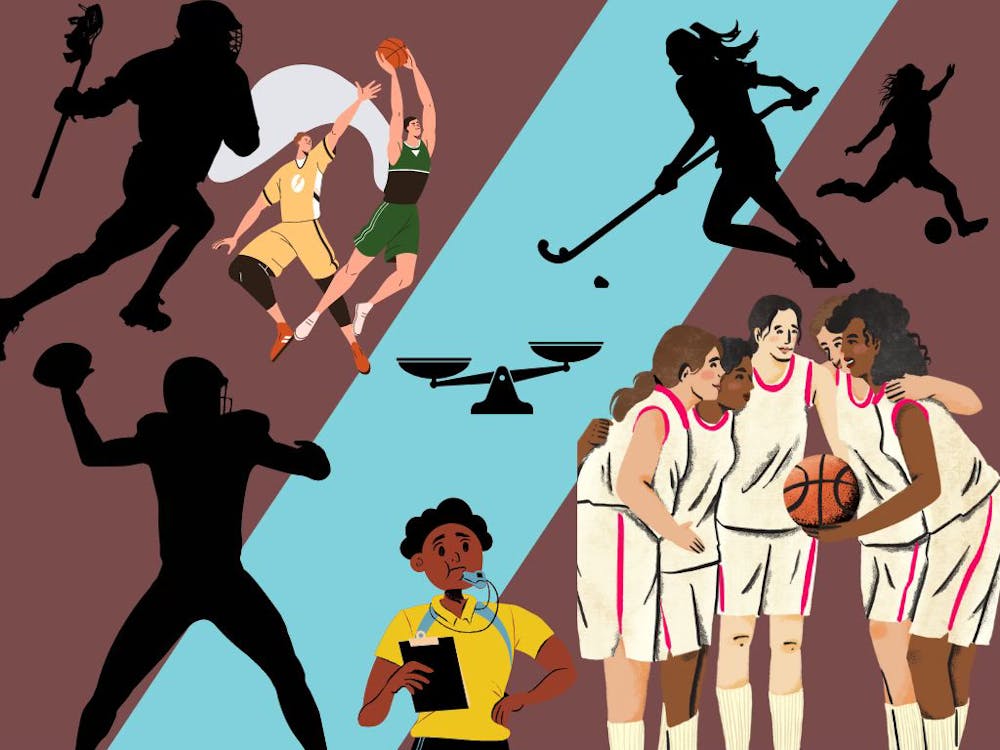Coaches for men's athletic teams at the University of Richmond on average earned $79,320 more than coaches for women's teams in 2021, according to federal data.
The U.S. Department of Education’s Equity in Athletics Data Analysis tool provides UR’s total coaches’ average compensation data from 2003 to 2021. Within those years is a consistent wage gap between head coaches running women’s teams versus men’s teams, the salary data shows. A national law called the Equity in Athletics Disclosure Act requires universities that receive federal funding to submit coach salaries to D.O.E. 's publicly available database.
According to the database, universities across the nation follow a similar trend. At William and Mary, a public university, coaches of men’s teams on average made $49,286 more in 2021 than head coaches of women’s teams.
These calculations are made when all the salaries of coaches for men’s teams are added together and then averaged, then compared to all the salaries of coaches for women’s teams that were added together and averaged.
Outliers, usually football and basketball coaches’ salaries, can skew the outcome of these gender comparisons when using this database.
This is particularly evident with big Division I athletic programs. For example, at Liberty University, football head coach Danny Freeze made over $3.4 million and men’s basketball head coach Ritchie McKay made just over $1.3 million, according to Liberty’s 990 forms. These outliers when calculated for average salaries had coaches of men’s teams at Liberty making $654,860 more in 2021-2022 than head coaches of women’s teams.
According to University of Richmond’s 990 form, Chris Mooney’s salary as head coach of the men’s basketball team was over $2.2 million in 2022.
Mooney received an additional $463,006 as “an estimated amount of other compensation from the organization and related organizations,” totaling his earnings to be just over $2.7 million. Mooney was the highest paid employee at UR that year, according to the 990 form.
UR’s 990 form for the 2022 tax year lists the 17 highest paid employees and no other coach made the list.
The 990 form stipulated that Mooney “occasionally travels with his team by means of charter travel for scheduled competition” and those fees are “not treated as taxable compensation.”
Charter travel can mean private planes, which allow passengers to avoid using traditional airports with security checkpoints.
A coach’s salary is determined by length of a coach’s tenure and how much revenue his or her sport brings to the university, among other factors, Jason Vida, assistant athletics director for communications for UR Athletics, wrote in an email to The Collegian.
Enjoy what you're reading?
Signup for our newsletter
Mooney is the third-longest tenured coach at a single school in the Atlantic 10 conference, according to UR’s website for athletic programs. The men’s basketball team has won 325 games in the last 18 seasons with Mooney, the most wins by any coach in UR history.
Vida declined to comment on the compensation differences between coaches of men’s and women’s teams.
UR has 17 varsity sports teams with seven men’s teams and 10 women’s teams, Vida wrote. He wrote that 11 of the varsity teams have a male head coach and five of the varsity teams have a female head coach. Field hockey currently has no head coach.
UR coaches from women’s teams had a greater increase in salary from 2018 to 2019 of about 9% on average, compared to UR coaches for men’s teams, who saw an average 5% increase during the same years.
Men’s team coaches at UR saw a greater salary decrease from 2019 to 2020 and again from 2020 to 2021, by approximately 17% and 23% respectively. Women’s team coaches at UR had a salary decrease of approximately 6% and 1% during those same years.
The decrease in salary between 2019 to 2021 was part of a national trend related to the COVID-19 pandemic, Scott Hirko, professor of sports administration and management at Wayne State University, said.
Hirko, a scholar in residence at the Syracuse Newhouse School of Public Communications, researches financial decisions in college sports and has written a soon-to-be-published pair of studies on salary differences between male and female coaches in the National Collegiate Athletic Association Division I Football Bowl Subdivision.
A 2018 study of compensations of men’s and women’s basketball coaches at the Division I level found “gender was not a statistically significant predictor” for wages. More important were “a host of revenue-specific variables,” including ticket sales as a primary factor to a coach’s salary.
Alex Traugutt, professor of sports management at Elon University and co-author of the study, said athletic departments look at what brings in the most revenue which then influences a coach’s salary.
Media companies, donors and audiences pay greater attention to men’s sports than women's sports, Traugutt said. The revenue earned from donations and ticket sales can impact a coach’s salary, which is why those in men’s sports get paid more, he said.
A retired UR field hockey coach, who asked to be anonymous to protect her job and relations with UR, said a part of why she stopped being a coach is because U.S college athletics invest more in men’s sports and pay less attention to women’s sports, which Traugutt says then dictates lower salaries for coaches of women’s teams.
“The inequity was starting to be really hard for me to sit with,” she said.
The retired field hockey coach said coaches “have no power” over the financial decisions athletic departments make. If a coach does call out an athletic department’s lack of support for women’s sports, that coach “will never have a job again,” she said.
Torin Rogers, a sophomore guard on the women’s basketball team at UR, said the female players feel the imbalance down to little things like how many more T-shirts the men’s team tosses into the audience during games. She sees these advertising methods as a big draw in bringing people to the games and wants to see more of these types of efforts made by UR to fill seats for the women’s games.
“We definitely have a smaller attendance [at] games,” she said.
Rogers said her basketball coach, Aaron Roussell, and the men’s head coach—top salary earner Mooney—put in equal effort and are equally committed to supporting their respective teams, and should get more equitable pay.
When athletic departments at U.S colleges receive donations without a strict designation for a specific team, the department decides what the donations support, Traugutt said.
Investing in men’s teams is a financially smart decision, he said, because men’s teams guarantee more revenue compared to women’s teams.
UR’s athletics department announced in a press release in April 2023 that they raised $800,000 during #URHere Giving Day. Men’s lacrosse and men’s basketball received the highest donations of $171,018 and $167,845 respectively. The press release said that women's tennis experienced an increase in donations, without disclosing the amount.
Unlike public universities, private institutions like UR are allowed to conceal data on donation amounts per team, what types of funding supports athletic teams and what coaches earn.
Traugutt said the answer to closing the gender salary gap in college sports is to market women’s sports more effectively to fill seats.
Hirko, of Wayne State, agreed that marketing would help, but said it has limitations because no single university can change the dynamic. It must be a collective effort among multiple universities to promote sports equity, he said.
Hirko added that the problem is with the business model for athletics programs at U.S. universities. Most invest in teams that “enhance prestige” to attract top student athletes.
But he said this model disadvantages coaches in women's sports because it builds on programs that are already money-makers. Instead, universities should diversify efforts in ways that help build prestige for women’s teams as well, to give those coaches more “equitable opportunities to make money in the coaching profession,” Hirko said.
The retired field hockey coach, who started off as an assistant coach at UR, said while she “made pennies on the hour” as a coach, she loved her time working with women athletes.
“We love what we do,” She said. “You can’t quantify it with a paycheck.”
UR women’s soccer Head Coach Adam Denton declined to speak specifically on the wage gap, but said the university complies with Title IX, the federal civil rights law that prohibits sex-based discrimination in educational programs, including college sports and coaching opportunities.
Under Title IX of the Education Amendments Act of 1972, the recipient of federal funding must “consider” equal “assignment and compensation” of coaches. Instances of unequal expenditures between male and female teams and inequitable salaries are still compliant with the law.
The 2023 U.S Department of Education’s “Title IX and Athletic Opportunities in Colleges and Universities'' resource guide says differences in coach salaries can be justified based on “experience, number of athletes, extra responsibility to supervise other coaches, outstanding record of achievement, nondiscriminatory factors related to the context of recruiting and hiring coaches for specific sports.”
Hirko said Title IX is helpful in ensuring that female athletes receive equal opportunities to play sports but that the law fails to resolve the problem of unequal compensation for coaches. He said this inequity can be resolved when athletic directors and university presidents work to invest more in women’s sports.
Hirko also noted more men are coaching Division I women’s sports than women, which is another aspect of gender inequality in college sports, he said.
“It is gender discrimination,” Hirko said. “Does the data show it? Absolutely.”
Contact Executive Editor Ananya Chetia at ananya.chetia@richmond.edu
Support independent student media
You can make a tax-deductible donation by clicking the button below, which takes you to our secure PayPal account. The page is set up to receive contributions in whatever amount you designate. We look forward to using the money we raise to further our mission of providing honest and accurate information to students, faculty, staff, alumni and others in the general public.
Donate Now



